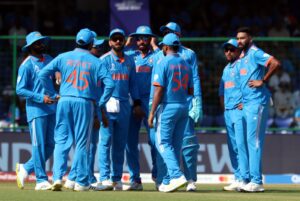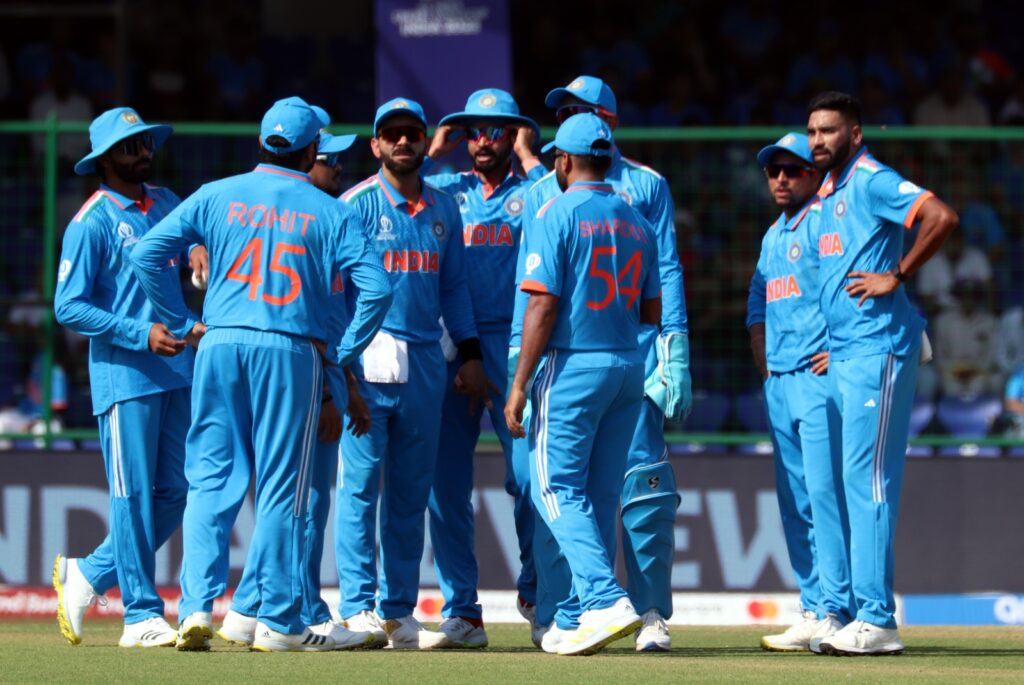
For a few minutes, if you scroll through the schedule of the round-robin phase of the 2023 World Cup, it feels like a string of trains stopping at different stations and chugging along right across the length and breadth of the country. As the first week of the seven-week-long tournament comes to a close, all 10 teams have played a couple of matches each. So, how are they shaping up? What are some of the positives that the teams can take from week 1? What about the drawbacks? Here’s a peek at what has worked and what hasn’t for the 10 sides.
India
The hosts were billed as the favourites before the start of the tournament, and they have vindicated that tag by winning their first two games. The biggest positive for India has been that the vital cogs in the line-up – Rohit Sharma, Virat Kohli, Jasprit Bumrah, KL Rahul and Kuldeep Yadav – have all found their groove. But in a team game, the ancillary parts too need to function smoothly.
In that respect, Ravindra Jadeja showcased his class by taking a three-for in spin-friendly conditions in Chennai. Shreyas Iyer and Ishan Kishan would draw some confidence from their respective knocks against Afghanistan. And the way India recovered from a precariously placed 2 for 3 against Australia also would have gladdened the think-tank.
So, is there any minor chink in India’s armour? There is the Shardul Thakur conundrum. Granted that he came into the World Cup as India’s highest wicket-taker since the 2019 edition, but he generally tends to be expensive with the ball. As a seam-bowling all-rounder, on his off days, he can look to compensate for it with the bat in hand. However, Shardul averages under 10 in his last 21 ODIs. Jadeja’s apparent lack of hitting prowess down the order is another question mark.
South Africa
The Proteas side perhaps came into the World Cup as a dark horse. But a couple of clinical performances against Sri Lanka and Australia have catapulted them to being one of the favourites to lift the coveted trophy. Quinton de Kock has looked in supreme touch, scoring two hundreds. Even on a Lucknow wicket offering tennis-ball bounce, he batted with a royal flourish. Aiden Markram and Rassie van der Dussen have also notched up scores of substance. In Heinrich Klaasen and David Miller, South Africa have more than enough firepower at the No. 5 and No. 6 batting slots.
Despite not having Anrich Nortje in their ranks, South Africa still have tall pace bowlers who cause some damage. We saw enough evidence of that in the game against Australia, where Kagiso Rabada, Lungi Ngidi and Marco Jansen shared the majority of the scalps. The Proteas also have Gerald Coetzee, whose deceptive pace gave enough headaches to the Sri Lanka batters. And when you throw in the spin pair of Keshav Maharaj and Tabraiz Shamsi, South Africa comes across as a side that has variety in the bowling department.
South Africa still have an issue or two to address. One of them is related to Jansen. The left-arm pace bowler has all the tools to become successful. Although he has made a promising start in Test cricket, the same can’t be said about his performances in the abridged versions of the game. He went for more than nine an over against Sri Lanka and that was followed by another slightly below-par show against Australia. Jansen is a useful batter lower down the order, but perhaps he plays a one spot too high at No. 7. Gone are those days of South Africa having a battery of all-rounders.
New Zealand
New Zealand were also considered one of the dark horses before they took on the reigning champions, England. The Black Caps side certainly made enough heads turn with a thumping nine-wicket win, and that was followed by a comfortable victory over the Netherlands. The backroom staff would be pleased with Rachin Ravindra’s impressive displays with the bat. Ever since he cracked a cover drive off Haris Rauf in a practice game, he hasn’t put a foot wrong – an unbeaten hundred followed by a fifty.
Devon Conway also composed a rollicking hundred in that crushing win over England. Among the bowlers, Matt Henry’s ability to bowl scrambled seam, supplemented by a hint of swing, has helped him to bag six wickets in just two games. Henry also has a well-directed bouncer up his sleeve. Trent Boult, his pace colleague, hasn’t exactly been at his best, but he did bowl a crucial little spell in the slog overs against England. Mitchell Santner, the wily spinner, has seven wickets to his name. He even landed a few lusty blows against the Netherlands.
So are there any concerns for the New Zealand camp? Probably Kane Williamson’s fitness. Williamson is arguably New Zealand’s finest-ever batter but he is returning from a serious injury. Incidentally, Tim Southee is also due back from a thumb injury.
Pakistan
It is still early doors in the tournament, but Pakistan seem to be one of the top four sides at the moment. And some credit for that has to go to the Muhammad Rizwan – Abdullah Shafique duet. The pair completely changed the complexion of the game against Sri Lanka with an alliance of 176 for the fourth wicket as they chased down a monstrous target of 345.
Shafique, known for his Test batting prowess, played a wide range of shots in that game. Meanwhile, Rizwan once again showed sound temperament under pressure. Saud Shakeel and Mohammad Nawaz also played vital hands in that famous win in Hyderabad. The other encouraging sign for Pakistan would be the form of Hasan Ali. The veteran pace bowler, who replaced Naseem Shah, already has six scalps. The pacer seems to have a knack for taking key wickets. Haris Rauf, the tearaway, also made an impression by running through the Netherlands’ middle order.
However, Pakistan would be a little worried about Shaheen Afridi’s rather modest performance so far. He has only two wickets to his name. In the game versus Sri Lanka, he was also guilty of bowling short and wide from around the wicket. Shadab Khan, the leg-spinner, too is struggling for form. He doesn’t seem to be imparting enough revs on the ball. Babar Azam, the skipper, also needs to bounce back after a couple of low scores.
England
The reigning champions probably began the tournament as the second-favourite behind India, but they hurtled to a humiliating defeat in the World Cup opener. England, though, bounced back strongly with an easy win over Bangladesh at Dharamsala. The two game-changers in that win were Reece Topley and Dawid Malan. The 6’7″ Topley was inexplicably left out of the first game. In England’s very next match, Topley put on an exhibition of seam and swing bowling, alongside extracting bounce with his tall frame and high release. He also possesses enough variations for the slogovers.
On the other hand, Malan accumulated his sixth hundred in just his 23rd ODI. Malan, the 36-year-old left-hand batter, has worked hard on his game against spin and has the necessary gear for the 50-over format. Joe Root’s 50-plus scores in the opening two games, Jonny Bairstow’s fifty and Mark Wood’s bowling with much better control against Bangladesh are the other positives to take for England.
There are still a few worry lines surrounding the England camp. One of them is related to the fitness of their talisman, Ben Stokes. Stokes has missed both games so far with a hip problem. In his absence, Harry Brook played some eye-catching shots but wasn’t able to convert starts into sizeable scores. There are also question marks over England’s second spinner, and Liam Livingstone’s inability to make an impact in major tournaments.
Bangladesh
The Bangladesh camp would have likely targeted progressing to the last four as their main goal. They even made a perfect start with a comfortable win against Afghanistan in Dharamsala. Just that they couldn’t match the overall strength and depth of England at the same ground. So, what has worked for them so far? Litton Das is at the top of the order, alongside Shakib Hasan’s classy spin bowling against Afghanistan. Mahedi Hasan also put on a gritty show at the death against England. The fielding too was creditworthy in that game. Shoriful Islam, the pace bowler, has mixed up his pace and has five wickets in the bank.
On the flip side, Shoriful’s pace colleagues – Mustafizur Rahman and Taskin Ahmed – have accounted for just three wickets between them. The biggest obstacle for Bangladesh is chasing down tall scores. With the tracks for the World Cup generally turning out to be placid, Bangladesh need to chart out a path in order to match other powerful batting units.
Australia
If a cricket fan woke up from hibernation, he or she might not believe that the five-time 50-over champions lost their opening two games and are currently the ninth-placed side on the points table. However, that is the stark reality for Australia. So, has something really worked for Australia in the opening two matches? Josh Hazlewood, for one, hit the deck hard and extracted considerable seam movement in the Chennai game. Mitchell Starc, his partner-in-crime, has also bowled incisively. Glenn Maxwell has been tidy with the ball.
When India were 2 for 3 in Chennai, the picture seemed rosier. Since then, it has all gone pear-shaped for the men from Down Under. Mitchell Marsh dropped a relatively easy chance off Kohli, which proved to be very costly. In their next game in Lucknow, Australia dropped as many as seven chances. It was a believe-it-or-not event to witness. Barring perhaps the Australian side from the mid-1980s, they have always been renowned for their fielding skills.
To make matters worse, none of the batters have scored a fifty so far. Pat Cummins, who had four catches dropped off his bowling in Lucknow, currently averages 104 with the ball. His captaincy too has come under scrutiny.
Sri Lanka
Sri Lanka also slipped to losses in their opening two games. In both those matches, the islanders showed flashes of brilliance. Kusal Mendis has been in sparkling form with scores of 76 and 122. Sadeera Samarawickrama also accrued a noteworthy century in Hyderabad. Pathum Nissanka, Dasun Shanaka and Charith Asalanka have a fifty each.
Their woes have come in the bowling and fielding departments. The Sri Lankan bowlers have taken only nine wickets combined, with Dilshan Madushanka scalping four of them. Matheesha Pathirana, who has some X-factor skills, averages a whopping 92.50 and has an economy rate of almost 10 an over. The pace bowler, who has a very slingy action, seems to be low on confidence. He also seems to be struggling with the direction of his front-arm. Sri Lanka’s fielders have also grassed chances, which hasn’t helped their cause.
Afghanistan and Netherlands
For Afghanistan, Hashmatullah Shahidi and Azmatullah Omarzai stitched a hundred-plus stand against India. Rahmanullah Gurbaz, the opener, seemed to be in good nick against Bangladesh. But the negatives clearly outweigh the positives. The likes of Najibullah Zadran and Rahmat Shah haven’t been among the runs for a while in ODIs. Their famed spin trio of Rashid Khan, Mujeeb Ur Rahman and Mohammed Nabi have only picked two wickets between them.
The Netherlands came into the World Cup with most of their players having little experience of playing in Indian conditions. To their credit, they have played well in patches. Bas de Leede has been the cornerstone of the Netherlands’ performance so far. He scored a fifty and bagged a four-for versus Pakistan. The veteran Colin Ackermann and Vikramjit Singh also have a fifty each.




